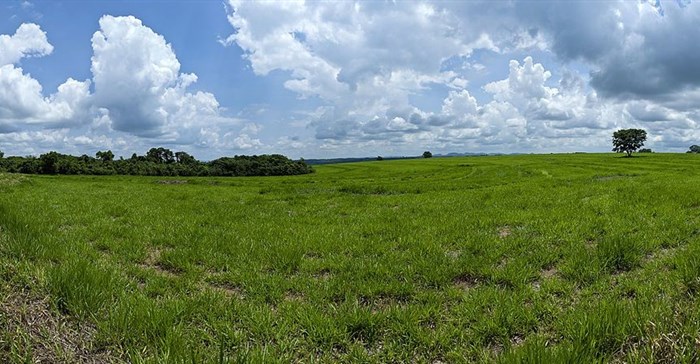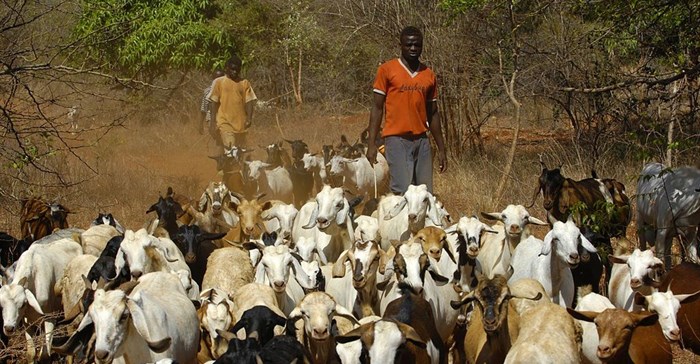How some African farmers are responding to climate change and what we can learn from them
Alternative animal feed, climate-friendly grasses and the use of fodder trees are among the examples providing farmers resilience and leading to benefits such as more productive livestock and new business opportunities - all while reducing greenhouse gas emissions and building healthy soils.
As unpredictable weather and natural disasters hamper food security across the globe, innovation will be paramount for the world's food producers, from smallholder farmers to industrial operations. Here are three novel ways African farmers are using adaptive strategies to thrive.
Brachiaria grass
In sub-Saharan Africa, some farmers are adapting to climate change by seeding pastures with Brachiaria grass. Some varieties of this forage can survive harsh conditions, such as drought and low fertile soils while helping to reduce the environmental impacts of livestock production.

In October 2016, a study by the International Center for Tropical Agriculture, CIAT for short, found that farmers in East Africa stood to produce 15-40 percent more milk and generate tens of millions of dollars in additional revenue by using the drought-tolerant grass.
Unlike Napier grass, which is forage used by many farmers in zero-grazing agricultural systems, production of Brachiaria is not constrained during the dry season, according to An Notenbaert, CIAT's forage coordinator for Africa.
"Farmers like Brachiaria because of its adaptability to low rainfall... and low fertility and acidic soils, and its production of green forage year round without any input of fertiliser," she says. "Brachiaria grass has [a] relatively high crude protein content due to greater leafiness and thinner stems than those of traditional Napier grass, resulting in higher nutritive quality."
One farmer who has witnessed the benefits of this grass is Albanas Nduva, who lives in Kikambuani village in eastern Kenya, an hour's drive east of Nairobi. He has 10 dairy cows on his five-hectare (12-acre) piece of land, of which 0.8 hectares (2 acres) has been set aside for planting Brachiaria grass. "The grass grows very fast compared to others, and I have observed increased milk production from my cows," says Nduva, who uses the grass as forage instead of pasture because his animals are kept in an enclosure. "I harvest the grass every two months, which is in contrast to other types, such as Napier, which matures at between three and four months." Nduva got 38 liters (10 gallons) of milk per cow daily before he began feeding them with the new grass. Now he gets 47 liters (12 gallons).
In 2012, with funding from the Swedish International Development Cooperation Agency, the Biosciences eastern and central Africa - International Livestock Research Institute and a number of other research facilities and organisations began studying new Brachiaria grasses in Kenya and Rwanda. They found that Brachiaria is good for the environment because cows easily digest it, reducing the release of methane, a potent greenhouse gas. In addition, because these grasses are deep-rooted they are able to sequester more carbon than other grasses.
More than 6,000 farmers are now growing the grass species across Kenya, according to Donald Njarui, senior principal scientist at the Kenya Agricultural and Livestock Research Organization, a corporate body that coordinates and promotes agricultural research and that's part of the Kenyan government. However, Njarui says, for wider dissemination and more research it will be necessary to register the grass species as varieties, which will allow seeds to be imported and opened to a global market.
"This will make it possible to import the seeds from any part of the world, unlike what is happening today," Njarui says - a key step since Brachiaria grass has become very important across the world, with seed production already commercialised in big cattle-producing countries like Brazil.
Nutrient block
As droughts become more frequent and more severe, pastoralists in northern Kenya are increasingly using a multi-urea nutrient block feed supplement for livestock as a coping mechanism when wild forage is in short supply.
Marsabit County, where more than three-quarters of rural residents live below the poverty line of 1,562 Kenyan shillings (about $15) per month, is an eight-hour drive north of Nairobi. Here, cyclical droughts are common and severely disrupt the people's livestock-dependent livelihoods, often causing massive livestock deaths due to lack of vegetation and water. However, Benson Mosor, the former food security field officer at Soliderités International, says that since the introduction of the multi-nutrient block, livestock deaths have gone down 10 percent.
Solidarités International, an international humanitarian organisation, helped train farmers to make and sell the blocks - which are a mixture of molasses, urea, salt, lime and other ingredients that help with bone formation, energy production and food absorption while providing necessary nutrients. "It was a big challenge to work with villagers at the beginning because they did not understand immediately what we were talking about," says Mosor. However, the nutrient block is gaining acceptance among pastoralists due to education efforts, according to Mosor.
A three to four-kilogramme (seven to nine-pound) block costs around 100 Kenyan shillings (about $1) to make and helps feed between four to five goats for a week, making it much cheaper than conventional feed. Corn-based feed, for instance, will cost between 2,000 to 3,300 Kenya shillings ($20 to$30) per week to feed the same number of animals.
Andrew Abudo, a 27-year old goatherd from Galasa village, says that since he began supplementing his animal feed with the nutrient block his goats are thriving, even in the face of severe drought. The United Nations issued an alert in December 2016 advising the country to brace itself for a worsening drought in 2017. "The animals will never die after feeding them on this block, unlike what used to happen before I started feeding it to my goats," says Abudo.

In addition to these benefits, a business opportunity has emerged, with villagers from Galasa making and selling the blocks. "We make these blocks to sell to outlying communities," explains Ali Elema, a member of this group. One block sells for 250 Kenya shillings ($2.50). The villagers have showcased their product in various forums, including the Kalacha Cultural Food and Music Festival, a popular gathering in Marsabit where pastoralists share knowledge and experience.
Planting fodder trees
Fodder trees are fast-growing trees that provide food for dairy cows and goats. The World Agroforestry Centre, or ICRAF, estimates that nearly a quarter-million farmers have planted these trees in Kenya, Tanzania, Uganda and Rwanda. "These trees are important for helping farmers adapt to climate change because, being deep-rooted, they are resistant to drought and maintain high-protein green fodder during the dry season, when the protein level of grasses decline[s]," says Steve Franzel, principal agricultural economist at ICRAF.

In addition, "the trees are generally planted as hedges and often along field contours, helping prevent soil erosion," says Franzel.
Mary Gichuki, a farmer who lives a few minutes' drive from Nairobi in Kiambu County, not only uses fodder trees on her land, but also sells tree seeds and seedlings and educates other farmers on using them. She began planting the trees in her small plot in 2006 after receiving training from ICRAF. "Farmers listen to me more because people have seen how the trees have lifted me from some level of poverty to where I am today," says Gichuki.
A two-kilogramme (four-pound) packet of the seeds will fetch her 6,000 Kenyan shillings ($60), and she has between 60 and 90 customers a month during the rainy season.
Increasingly important innovations
Irregular and erratic weather is a big impediment for improving crop yields for smallholder farmers, especially in a region that depends on rain-fed agriculture. Meanwhile, food security will continue to be a global issue affecting much of the world's population. Innovations that make farms less vulnerable to wide swings in conditions will become increasingly important as climate changes and population grows. Productive, affordable and accessible practices like these could make all the difference between barely surviving and thriving in an increasingly uncertain future.
Source: allAfrica

AllAfrica is a voice of, by and about Africa - aggregating, producing and distributing 2000 news and information items daily from over 130 African news organisations and our own reporters to an African and global public. We operate from Cape Town, Dakar, Lagos, Monrovia, Nairobi and Washington DC.
Go to: http://allafrica.com/Related
Cities face 'whiplash' of floods, droughts as temperatures rise, study warns 12 Mar 2025 Government publishes National Greenhouse Gas Inventory Report 11 Feb 2025 Study reveals soil health's impact on wine flavour profiles 23 Aug 2024 Climate Change Act: Improve reporting or face the consequences 29 Jul 2024 FMD hits 24 ECape farms, quarantine and vaccination underway 22 Jul 2024 Research into climate change adaptation and mitigation receives $92m 5 Jun 2024























